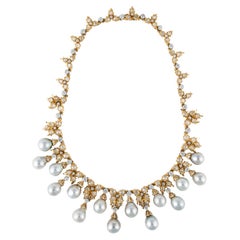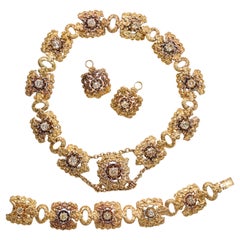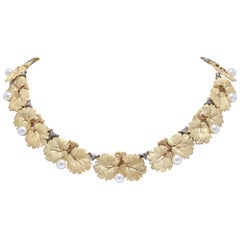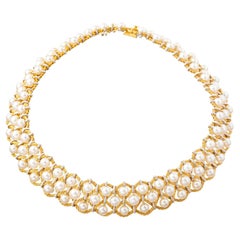Buccellati Gold Pearl Choker Necklace
Vintage 1980s Italian Choker Necklaces
Diamond, Cultured Pearl, 18k Gold, White Gold, Yellow Gold
Vintage 1950s Renaissance Revival Choker Necklaces
Diamond, 18k Gold
Recent Sales
21st Century and Contemporary Unknown Modern Choker Necklaces
Cultured Pearl, 18k Gold, Yellow Gold
21st Century and Contemporary Italian Modern Choker Necklaces
Pearl, 18k Gold
20th Century Italian Choker Necklaces
Diamond, Cultured Pearl
Vintage 1950s Italian Multi-Strand Necklaces
Lapis Lazuli, Cultured Pearl, 18k Gold
People Also Browsed
1990s Italian Suits, Outfits and Ensembles
1990s Evening Gowns
1990s Italian Jackets
1990s Italian Evening Dresses and Gowns
1990s French Blazers
2010s American Evening Dresses
1990s Italian Day Dresses
1990s Italian Bodysuits
1990s French Cocktail Dresses
1990s French Jumpsuits
1990s Italian Cocktail Dresses
1990s British Jackets
1990s Italian Evening Dresses and Gowns
Early 2000s Evening Dresses and Gowns
21st Century and Contemporary British Blouses and Tops
1990s French Evening Dresses and Gowns
Buccellati for sale on 1stDibs
In 1919, Mario Buccellati (1891–1965) launched his eponymous jewelry house with the opening of his first shop in Milan and quickly built a reputation for his richly embellished traforato, or finely pierced goldwork. The Ancona, Italy–born jeweler’s workmanship was in a class of its own. His pieces were exquisite, yet the gemstones themselves were never too flashy, elevated instead by the designs’ intricate metalsmithing.
A love of tradition set Mario and his fine jewelry house apart in the competitive Italian market and remains a point of pride for the family, which is still closely tied to the business even as it is now owned by Richemont, a luxury conglomerate that also counts Cartier and Van Cleef & Arpels among its subsidiaries.
A young Mario Buccellati apprenticed with famed goldsmith Beltrami e Besnati in the early 1900s, although many of the goldsmithing techniques synonymous with Buccellati go as far back as the Italian Renaissance. The family lineage is also said to include 18th-century jeweler Contardo Buccellati.
Owing to the founder’s advanced metalworking skills, the brand is known for designs that feature metal with the delicacy of lace and draw on the wonders of the natural world. The house’s work is typified by intricate gemstone settings that emphasize their natural color and dense engraving techniques that transform the texture of gold.
One of the time-honored engraving techniques that has come to characterize Buccellati’s work — techniques that require apprenticeships and training in the fine jeweler’s workshops — is called rigato. It involves the engraving of a precious metal with a series of parallel lines to achieve a fabric-like effect.
Rigato is on luminous display in the house’s Macri collection of earrings, cuff bracelets and other accessories. A painstaking attention to detail is pronounced in the celebrated Macri, Bartolomeo and Unica collections — witness the striking honeycomb motif, a house signature, that characterizes the Unica collection’s Caterina bracelet, for example.
The Macri collection was the work of Mario’s son, Gianmaria Buccellati, an award-winning jeweler and internationally renowned silversmith who worked to bring the brand to the global stage by overseeing the opening of boutiques in Tokyo, Paris, California and elsewhere.
In 1951, Mario opened his first store in New York City; today the company operates boutiques worldwide. In 2019, the company celebrated its centennial with a new flagship in Paris and the Vintage collection, which features some of its most enduring designs.
On 1stDibs, find a collection of authentic Buccellati jewelry, including earrings, necklaces, rings and other accessories.
The Legacy of Pearl in Jewelry Design
The pearl has been synonymous with ladylike elegance since the Tudor period — learn what to look for when shopping for vintage and antique pearl jewelry as well as how to tell the origin of a pearl with our handy primer.
Every woman at some point in her life desires a simple strand of pearls. They are elegant, timeless, versatile — just ask Coco Chanel or Jacqueline Kennedy — and valuable. In 1917, Pierre Cartier famously traded a double-strand of natural pearls for a Fifth Avenue mansion, the Cartier brand’s flagship store ever since. And if you were born in the beginning of summer, pearl is the June birthstone.
It is possible to tell where a pearl originated from its appearance. Akoyas are usually round and white — the classic pearl, if you will. South Sea pearls are normally larger and vary in color; orangey yellow ones are not uncommon. Tahitian pearls are mostly black but can also be gray or brown, and between the Akoya and the South Sea varieties in size. Freshwater pearls, or Orientals, run the gamut in terms of color and size, but in shape, they tend to resemble Rice Krispies. Another important distinction is a round pearl versus a baroque pearl. A round pearl is self-explanatory, but there are two types of baroque pearls: symmetrical and asymmetrical. In general, the symmetrical variation commands a higher valuation. Within a strand of pearls, uniformity is prized — the more the individual pearls resemble one another, the more valuable the strand.
According to the Gemological Institute of America (GIA), the earliest recorded mention of a pearl was in 2206 BC by a Chinese historian. Centuries later, Christopher Columbus made it a point to visit pearl fisheries during his 15th-century exploration of the Caribbean. Since the late-19th century, the Japanese have been at the forefront of cultivating pearls, when jeweler Kokichi Mikimoto successfully cultured the world’s first pearl in 1893.
On 1stDibs, find vintage and antique pearl necklaces, pearl earrings and other accessories.
Finding the Right Choker-necklaces for You
Vintage choker necklaces are elegant, alluring and stylish. Cameos, pearls, diamonds and other stones can decorate these necklaces, which come in single or multiple strands. Whether it is a statement piece or a delicate chain, these short necklaces always stand out and turn heads.
The history of the choker can be traced back thousands of years, with Sumerian examples discovered from 2600–2500 B.C. They endured as a popular form of adornment through the centuries, and during the French Revolution they took on a symbolic significance. Women wore ribbons around their throats to mark the passing of those killed by the guillotine. Soon, the plain ribbons were adorned with small cameos and other ornamentation.
European choker necklaces gained a salacious reputation in the 19th century when prostitutes were associated with black ribbons tied around the neck, such as the model in Édouard Manet’s Olympia (1863). Queen Alexandra, Princess of Wales, reversed the trend in the late 19th century by wearing a large pearl and diamond choker, reputedly to hide a scar.
Fashioned from gold, pearls and other precious stones and metals, chokers continued to be worn into the 20th century, alternately statements of wealth and rebellion. They experienced periods of revival in the 1920s, ’40s, ’70s and ’90s for both men and women.
Vintage chokers make a statement with an unmistakable air of femininity. On 1stDibs, find an alluring collection of vintage chokers today, including gold, sapphire and emerald chokers.



